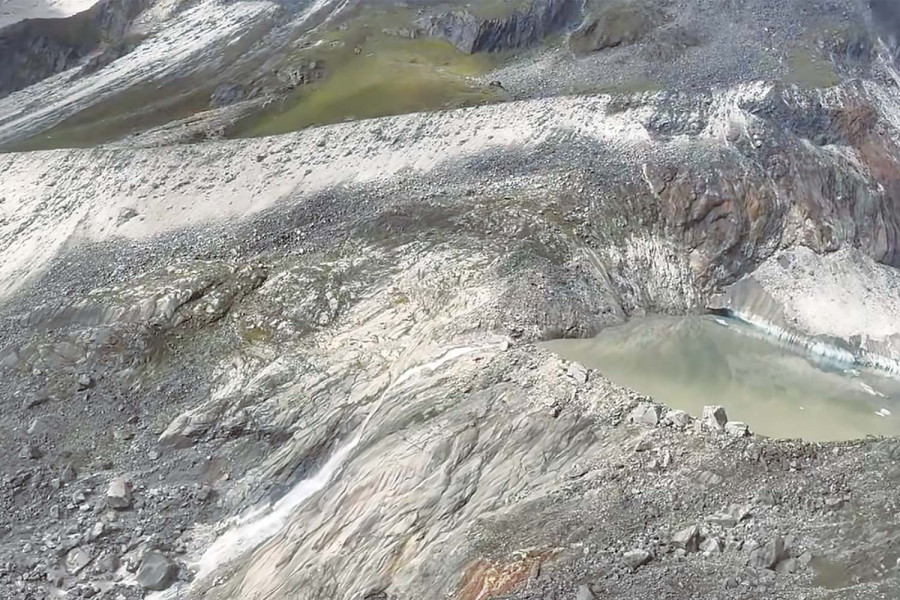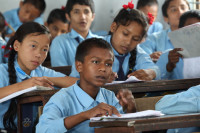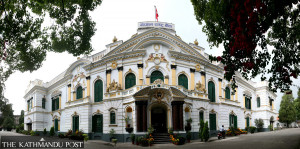Columns
Escalating climate change impacts
Countries in the Hindu Kush region must collaborate and share information on glaciers for disaster mitigation.
Keshab Sharma
The Hindu Kush Himalayan (HKH) region is one of the world’s most fragile and hazard-prone regions. Shifting snowfall and rainfall patterns due to climate change increase the region’s vulnerability. Cloudburst events are becoming more frequent, glaciers are retreating at an accelerated pace, snowfall is declining and permafrost is melting, leading to a cascade of multi-hazard events that cause substantial damage.
While significant attention has been given to mapping glacial lakes larger than 0.02 square kilometres and monitoring a few potentially dangerous ones, other critical hazards, such as permafrost degradation and smaller, undocumented glacial lakes, have been overlooked. Additionally, there has been insufficient focus on minimising vulnerability and exposure downstream, which are the key components of disaster risk reduction.
Glacial lake outburst floods
Glacial lake outburst floods (GLOFs) occur when meltwater from glaciers accumulates behind an ice or moraine dam, which can fail due to overtopping caused by rising water levels or collapse resulting from melting of the ice core within the moraine dam. This failure often triggers external events such as avalanches or landslides into the lake. The GLOF event in April this year at Birendra Lake in Gorkha, Nepal, highlights the severe impact of glacier ice cascading into the lake. This sudden influx caused a sharp rise in water levels, leading to an overflow that inundated downstream areas.
Earthquakes may also trigger the GLOF. The 2015 Gorkha earthquake brought about a GLOF in the Langtang Valley by destabilising the Langtang Glacier. The sudden release of large volumes of water generates catastrophic floods that can overwhelm river channels and pose severe risks to nearby communities and critical infrastructure like hydropower and bridges.
On August 16, 2024, a GLOF devastated Thame, a Sherpa village in the Khumbu region, destroying 25 structures, including homes, guesthouses, a school and a hydropower project, while displacing 135 people. Additionally, the Khumbu region was severely impacted by the Dig Tsho GLOF in 1985, which caused widespread destruction, including the loss of lives, property and infrastructure.
The 2021 Melamchi debris flow was triggered by monsoon rainfall and landslides and exacerbated by upstream glacial melt, leading to devastating floods and sediment-laden flows. Similarly, the 2012 Seti River flash flood in Pokhara was caused by a landslide-induced dam breach upstream, which released a massive volume of water, highlighting the cascading risks associated with glacial melt and moraine instability linked to GLOF phenomena. All these GLOF-related events underline the need for robust multihazard early warning systems, risk mitigation measures and strong design of critical infrastructures.
In the Himalaya, GLOFs can trigger a series of landslide dam outburst floods (LDOFs) by releasing large volumes of water that destabilise slopes or transport debris downstream, causing landslides that dam rivers. The sudden surge of water and debris from a GLOF can block a river course, forming a temporary dam, which, if breached, results in a catastrophic LDOF.
The recent Thame GLOF is a stark reminder of the urgent need for better disaster risk management and more comprehensive monitoring strategies in the Himalaya. It also points to a crucial gap in existing glacial lake inventories. This lake was not included in the inventory because its size fell below the minimum threshold for classification as a glacial lake. Despite its small size, the flood caused significant downstream damage, destroying houses and infrastructure. The potential for widespread destruction is immense, with thousands of such lakes scattered across the Himalaya.
Permafrost degradation
Permafrost is a soil, rock, or sediment layer that remains frozen for at least two consecutive years, typically found in polar and high-altitude regions. But this is rapidly degrading due to rising temperatures. This thawing process weakens moraine dams, increasing the risk of GLOFs. Thorthormi Lake in Bhutan is classified as high-risk because of permafrost degradation. Furthermore, thawing releases loose debris, which triggers debris flows during heavy rainfall or snowmelt. In India’s Ladakh region, recurring debris flows caused by permafrost degradation have severely impacted local communities and infrastructure.
Another consequence of permafrost thaw is increased sedimentation in rivers and reservoirs. Thawed permafrost accelerates erosion, contributing to higher sediment loads, as observed in Pakistan’s Indus River Basin. This disrupts river dynamics and reduces the efficiency of hydropower projects or threatens the bridges.
Permafrost thawing in Nepal is a critical yet overlooked issue, with no systematic monitoring or comprehensive studies to assess its status and impacts. The lack of awareness and action on this phenomenon leaves communities vulnerable to landslides, glacial lake outbursts, floods and sedimentation.
Building resilience
Glacier retreat and permafrost thaw also undermine the stability of mountain slopes and infrastructure integrity. As glaciers and permafrost diminish, the once-stabilised rocks are now exposed, increasing the risk of landslides and debris flow. Several studies have reported the growing trend of large landslides and debris flow in the Himalayas over the last decade, which is associated with glacier decline.
In the Hindu Kush Himalaya, the rising temperatures caused by climate change driving glacier melt and permafrost degradation is a global phenomenon, and reversing or halting these processes is beyond the practical scope of localised or national efforts. Reducing global warming or the effect of climate change is a long-term challenge, requiring worldwide commitment and immediate action. Similarly, while efforts like lowering water levels in glacial lakes are technically possible in select cases, as done with Nepal’s Tsho Rolpa and Imja Tsho, they only provide temporary relief. They are not sustainable solutions given the thousands of lakes already formed and the hundreds that emerge annually due to accelerating glacier melt.
Given these limitations, a pragmatic and effective strategy focusing on managing vulnerability to climate-induced hazards through innovative risk assessments, resilient infrastructure and community engagement is imperative. Critical infrastructure such as hydropower plants, bridges, roads and settlements must be designed to accommodate high hydraulic forces and debris flows. Infrastructure planning should integrate hazard mapping and predictive modelling to avoid high-risk zones and reduce exposure.
In addition to physical infrastructure, strengthening multihazard early warning systems and enhancing community preparedness are vital. Combining technological advancements with local knowledge enables timely evacuation and risk mitigation, minimising human and economic losses. Community-based disaster risk reduction is also crucial. Empowering local populations through education, participatory mapping and hazard preparedness can significantly reduce disaster impacts. Additionally, integrating insurance and reinsurance mechanisms tailored for Himalayan risks can further encourage investment in resilient infrastructure.
Investing in research and innovation is equally critical. Remote sensing and machine learning technologies can improve hazard monitoring and predictive modelling, offering new insights into glacial dynamics and risk patterns. Incorporating future climate scenarios into risk assessments will help policymakers and communities prepare for the uncertainties of climate change.
This isn't a national problem, as glacial melting in Tibet can also pose risks to Nepal and India. There needs to be a consensus among the countries in the Hindu Kush region for collaboration and information sharing on glaciers across borders. We can only comprehensively monitor the dangers posed by retreating glaciers and effectively prepare for potential disasters through such cooperation.




 13.12°C Kathmandu
13.12°C Kathmandu















